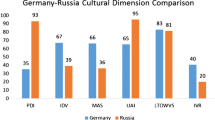Abstract
Working people often have different notions and attitudes toward leadership based on cultural background and context as well as various demographic traits. This study examines the leadership orientations of 519 Russian working adults based on age, gender, education, and government work experience. It appears that they are more relationship-oriented than task-oriented. Task-oriented leadership is the preferred style in government sector. Age and gender appear to be significant factors in determining the difference of task-oriented traits as older Russian people tend to be more task-oriented than younger Russian people and Russian males are more task-oriented than Russian females. Education appears to make a difference in the relationship but not in the task scores. In this paper, Russian history, culture and leadership, as well as the behavioral approach to leadership are presented along with practical implications and suggestions for managers, practitioners and future studies.

Similar content being viewed by others
References
Ageev, A., Gratchev, M., & Hisrich, R. (1995). Entrepreneurship in the Soviet Union and Post-Socialist Russia. Small Business Economics, 7(5), 365–376.
Australian Government (Department of Foreign Affairs and Trade) (2013). Russian Federation. Retrieved from http://www.dfat.gov.au/geo/fs/russ.pdf
Ayios, A. (2004). Trust and Western-Russian business relationships. Aldershot: Ashgate.
Batchelder, D. (1996). The emperor’s pot. In H. N. Seelye (Ed.), Experiential activities for intercultural learning (pp. 85–96). Boston: Intercultural Press, Inc.
Berliner, J. S. (1988). The innovation decision in the soviet industry. Cambridge: MIT Press.
Bollinger, D. (1994). The four cornerstones and three pillars in the ‘House of Russia’ management system. Journal of Management Development, 13(2), 49–54.
Carr, C. (2006–2007). Russian strategic investment decision practices compared to those of Great Britain, Germany, the United States, and Japan. International Studies of Management and Organization, 36(4), 82–110.
Elenkov, D. S. (1995). Russian aerospace multinational companies (MNCS) in global competition: Their origin, competitive strengths and forms of expansion. Columbia Journal of World Business, 30(2), 66–78.
Goskomstat Russia (Russian Federation Federal State Statistical Service) (2014). Retrieved from http://www.gks.ru/wps/wcm/connect/rosstat_main/rosstat/ru/statistics/population/demography/
Hofstede, G. (1980). Motivation, leadership, and organization: Do American theories apply abroad? Organizational Dynamics, 9(1), 42–63.
Hofstede, G. (1983). Dimensions of national cultures in fifty countries and three regions. In J. B. Deregowski, S. Dziurawiec, & R. C. Annis (Eds.), Expiscations in cross-cultural psychology (pp. 335–355). Lisse: Swets & Zeitlinger.
Hofstede, G. (1991). Culture and organizations: Software of the mind. New York: McGraw-Hill.
Hofstede, G. (1993). Cultural constraints in management theories. In J. T. Wren (Ed.), The leader’s companion (pp. 253–270). New York: Free Press.
Hofstede, G. (2012). The Hofstede Centre, 2012 database. Retrieved from http://geert-hofstede.com/russia.html
Hofstede, G., & Bond, M. H. (1988). The Confucius connection: from cultural roots to economic growth. Organizational Dynamics, 16(4), 4–21.
Holt, D. H., Ralston, D. A., & Terpstra, R. H. (1994). Constraints on capitalism in Russia: the managerial psyche, social infrastructure, and ideology. California Management Review, 36(3), 124–141.
House, R., Javidan, M., Hanges, P., & Dorfman, P. (2002). Understanding cultures and implicit leadership theories across the globe: an introduction to project GLOBE. Journal of World Business, 37, 3–10.
Kets de Vries, M. (2000). A journey into the Wild East: leadership style and organizational practices in Russia. Organizational Dynamics, 28(4), 67–81.
Kuznetsov, A., & Kuznetsova, O. (2005). Business culture in modern Russia: deterrents and influences. Problems and Perspectives in Management, 2(2), 25–31.
Lawrence, P., & Vlachoutsicos, C. (1990). Behind the factory walls: decision making in Soviet and U.S. Enterprises. Boston: Harvard Business School Press.
Matveev, A. V. (2002). The perception of intercultural communication competence by American and Russian managers with experience on multicultural teams, Dissertation, Ohio University. Ann Arbor, MI: UMI Dissertation Services.
Naumov, A., & Puffer, S. (2000). Measuring Russian culture using Hofstede’s dimensions. Applied Psychology: An International Review, 49(4), 709–718.
Nguyen, L. D., & Mujtaba, B. G. (2011). Stress, task, and relationship orientation of Vietnamese: an examination of gender, age, and government work experience in the Asian culture. Competition Forum, 9(2), 235–246.
Nguyen, L. D., Mujtaba, B. G., & Ruijs, A. (2013). Stress, task, and relationship orientations of Dutch: do age, gender, education, and government work experience make a difference? Public Organization Review. doi:10.1007/s11115-013-0222-2.
Northouse, P. G. (2007). Leadership: Theory and practice (4th ed.). Thousand Oaks: Sage Publications.
Puffer, S. (1994). Understanding the bear: a portrait of Russian business leaders. Academy of Management Executive, 8(1), 41–54.
Puffer, S., & McCarthy, D. (2011). Two decades of Russian business and management research: an institutional theory perspective. Academy of Management Perspectives, 25(2), 21–37.
Terpstra, V., & David, K. (1985). The cultural environment of international business. Cincinnati: South–Western.
Author information
Authors and Affiliations
Corresponding author
Rights and permissions
About this article
Cite this article
Nguyen, L.D., Ermasova, N., Geyfman, V. et al. Leadership Orientations of Russian Working Adults: Do Age, Gender, Education, and Government Work Experience Make a Difference?. Public Organiz Rev 15, 399–413 (2015). https://doi.org/10.1007/s11115-014-0279-6
Published:
Issue Date:
DOI: https://doi.org/10.1007/s11115-014-0279-6




